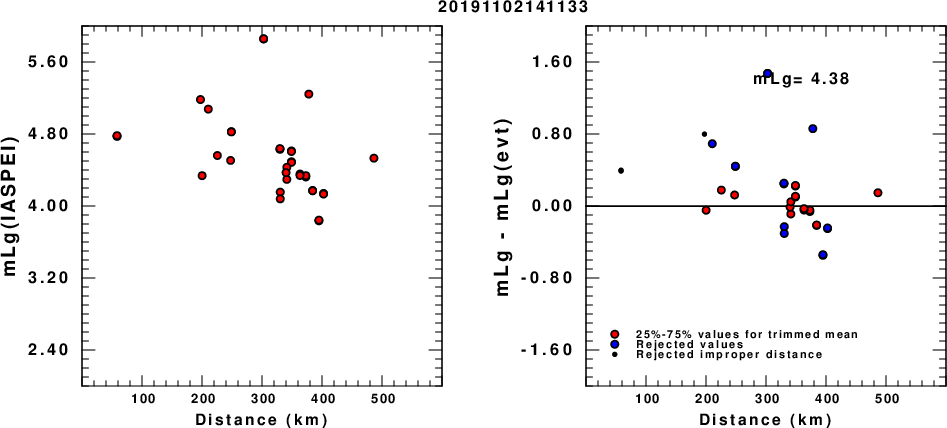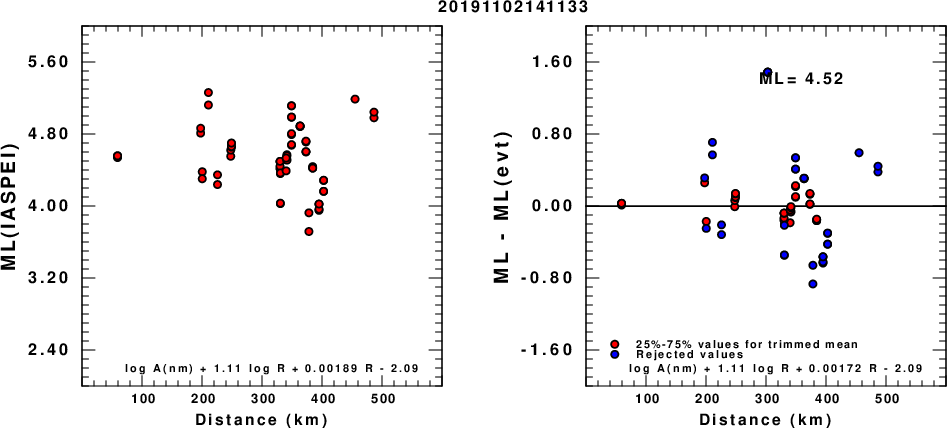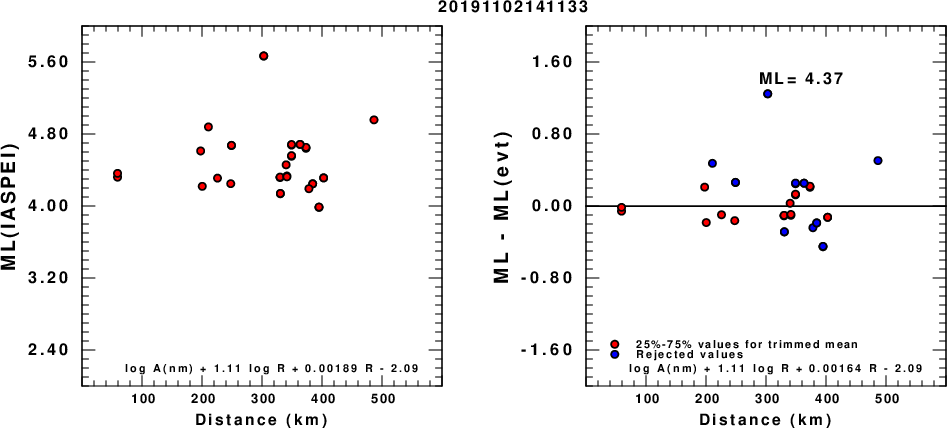
(a) mLg computed using the IASPEI formula; (b) mLg residuals ; the values used for the trimmed mean are indicated.
USGS/SLU Moment Tensor Solution
ENS 2019/11/02 14:11:33:5 44.32 17.61 10.0 4.7 Bosnia-Herzegovina
Stations used:
AC.KBN CR.ZAG HU.BEHE HU.KOVH HU.MORH MN.BLY MN.PDG MN.TRI
OE.MYKA OE.OBKA OE.SOKA OX.DRE OX.PRED OX.SABO RO.BZS
RO.MDVR RO.SIRR SJ.FRGS
Filtering commands used:
cut o DIST/3.3 -30 o DIST/3.3 +70
rtr
taper w 0.1
hp c 0.02 n 3
lp c 0.06 n 3
Best Fitting Double Couple
Mo = 1.86e+23 dyne-cm
Mw = 4.78
Z = 18 km
Plane Strike Dip Rake
NP1 235 65 -30
NP2 339 63 -152
Principal Axes:
Axis Value Plunge Azimuth
T 1.86e+23 1 287
N 0.00e+00 52 19
P -1.86e+23 38 196
Moment Tensor: (dyne-cm)
Component Value
Mxx -8.95e+22
Mxy -8.35e+22
Mxz 8.81e+22
Myy 1.61e+23
Myz 2.15e+22
Mzz -7.13e+22
--------------
#######---------------
############----------------
###############---------------
##################-------------##-
####################----############
###################---###############
T ################-------###############
##############---------###############
##############-------------###############
############----------------##############
##########-------------------#############
#########--------------------#############
######----------------------############
#####------------------------###########
###-------------------------##########
#------------ -----------#########
------------ P -----------########
---------- -----------######
-----------------------#####
-------------------###
--------------
Global CMT Convention Moment Tensor:
R T P
-7.13e+22 8.81e+22 -2.15e+22
8.81e+22 -8.95e+22 8.35e+22
-2.15e+22 8.35e+22 1.61e+23
Details of the solution is found at
http://www.eas.slu.edu/eqc/eqc_mt/MECH.NA/20191102141133/index.html
|
STK = 235
DIP = 65
RAKE = -30
MW = 4.78
HS = 18.0
The NDK file is 20191102141133.ndk The waveform inversion is preferred.
The following compares this source inversion to others
USGS/SLU Moment Tensor Solution
ENS 2019/11/02 14:11:33:5 44.32 17.61 10.0 4.7 Bosnia-Herzegovina
Stations used:
AC.KBN CR.ZAG HU.BEHE HU.KOVH HU.MORH MN.BLY MN.PDG MN.TRI
OE.MYKA OE.OBKA OE.SOKA OX.DRE OX.PRED OX.SABO RO.BZS
RO.MDVR RO.SIRR SJ.FRGS
Filtering commands used:
cut o DIST/3.3 -30 o DIST/3.3 +70
rtr
taper w 0.1
hp c 0.02 n 3
lp c 0.06 n 3
Best Fitting Double Couple
Mo = 1.86e+23 dyne-cm
Mw = 4.78
Z = 18 km
Plane Strike Dip Rake
NP1 235 65 -30
NP2 339 63 -152
Principal Axes:
Axis Value Plunge Azimuth
T 1.86e+23 1 287
N 0.00e+00 52 19
P -1.86e+23 38 196
Moment Tensor: (dyne-cm)
Component Value
Mxx -8.95e+22
Mxy -8.35e+22
Mxz 8.81e+22
Myy 1.61e+23
Myz 2.15e+22
Mzz -7.13e+22
--------------
#######---------------
############----------------
###############---------------
##################-------------##-
####################----############
###################---###############
T ################-------###############
##############---------###############
##############-------------###############
############----------------##############
##########-------------------#############
#########--------------------#############
######----------------------############
#####------------------------###########
###-------------------------##########
#------------ -----------#########
------------ P -----------########
---------- -----------######
-----------------------#####
-------------------###
--------------
Global CMT Convention Moment Tensor:
R T P
-7.13e+22 8.81e+22 -2.15e+22
8.81e+22 -8.95e+22 8.35e+22
-2.15e+22 8.35e+22 1.61e+23
Details of the solution is found at
http://www.eas.slu.edu/eqc/eqc_mt/MECH.NA/20191102141133/index.html
|
Balkan Region
Epicenter: 44.34 17.56
MW 4.8
GFZ MOMENT TENSOR SOLUTION
Depth 10 No. of sta: 156
Moment Tensor; Scale 10**16 Nm
Mrr= 2.17 Mtt=-2.08
Mpp=-0.09 Mrt=-0.69
Mrp=-0.44 Mtp= 0.39
Principal axes:
T Val= 2.38 Plg=75 Azm=130
N -0.14 13 277
P -2.24 8 9
Best Double Couple:Mo=2.3*10**16
NP1:Strike=113 Dip=39 Slip= 111
NP2: 267 54 74
------- P -
---------- ----
-----------------------
-------------------------
-----------------------------
---------------#-------------
#------##################------
##---########################----
##-#############################-
#--############## #############
----############# T #############
------########### #############
------#########################
-------######################
----------################---
-------------------------
-----------------------
-----------------
-----------
Analysis performed automatically
Last updated 2019-11-02 15:44:44 UTC
|

(a) mLg computed using the IASPEI formula; (b) mLg residuals ; the values used for the trimmed mean are indicated.

(a) ML computed using the IASPEI formula for Horizontal components; (b) ML residuals computed using a modified IASPEI formula that accounts for path specific attenuation; the values used for the trimmed mean are indicated. The ML relation used for each figure is given at the bottom of each plot.

(a) ML computed using the IASPEI formula for Vertical components (research); (b) ML residuals computed using a modified IASPEI formula that accounts for path specific attenuation; the values used for the trimmed mean are indicated. The ML relation used for each figure is given at the bottom of each plot.
 |
The focal mechanism was determined using broadband seismic waveforms. The location of the event and the and stations used for the waveform inversion are shown in the next figure.

|
|
|
The program wvfgrd96 was used with good traces observed at short distance to determine the focal mechanism, depth and seismic moment. This technique requires a high quality signal and well determined velocity model for the Green functions. To the extent that these are the quality data, this type of mechanism should be preferred over the radiation pattern technique which requires the separate step of defining the pressure and tension quadrants and the correct strike.
The observed and predicted traces are filtered using the following gsac commands:
cut o DIST/3.3 -30 o DIST/3.3 +70 rtr taper w 0.1 hp c 0.02 n 3 lp c 0.06 n 3The results of this grid search from 0.5 to 19 km depth are as follow:
DEPTH STK DIP RAKE MW FIT
WVFGRD96 1.0 265 45 65 4.45 0.3599
WVFGRD96 2.0 265 50 65 4.57 0.4753
WVFGRD96 3.0 115 45 110 4.64 0.5380
WVFGRD96 4.0 270 45 75 4.67 0.5394
WVFGRD96 5.0 245 55 45 4.63 0.5105
WVFGRD96 6.0 230 80 25 4.59 0.5139
WVFGRD96 7.0 230 85 20 4.61 0.5260
WVFGRD96 8.0 235 75 30 4.65 0.5396
WVFGRD96 9.0 230 65 -35 4.69 0.5576
WVFGRD96 10.0 230 65 -35 4.70 0.5727
WVFGRD96 11.0 230 65 -35 4.71 0.5850
WVFGRD96 12.0 235 70 -30 4.72 0.5949
WVFGRD96 13.0 235 70 -30 4.73 0.6025
WVFGRD96 14.0 235 70 -30 4.74 0.6080
WVFGRD96 15.0 235 70 -30 4.75 0.6116
WVFGRD96 16.0 235 65 -30 4.76 0.6142
WVFGRD96 17.0 235 65 -30 4.77 0.6155
WVFGRD96 18.0 235 65 -30 4.78 0.6158
WVFGRD96 19.0 235 65 -30 4.78 0.6152
WVFGRD96 20.0 235 65 -30 4.79 0.6139
WVFGRD96 21.0 235 65 -30 4.80 0.6117
WVFGRD96 22.0 235 65 -30 4.81 0.6092
WVFGRD96 23.0 235 65 -30 4.81 0.6057
WVFGRD96 24.0 235 65 -30 4.82 0.6013
WVFGRD96 25.0 235 60 -30 4.83 0.5969
WVFGRD96 26.0 235 60 -30 4.83 0.5920
WVFGRD96 27.0 235 60 -30 4.84 0.5860
WVFGRD96 28.0 235 60 -30 4.84 0.5793
WVFGRD96 29.0 235 60 -30 4.85 0.5717
The best solution is
WVFGRD96 18.0 235 65 -30 4.78 0.6158
The mechanism correspond to the best fit is

|
|
|
The best fit as a function of depth is given in the following figure:

|
|
|
The comparison of the observed and predicted waveforms is given in the next figure. The red traces are the observed and the blue are the predicted. Each observed-predicted component is plotted to the same scale and peak amplitudes are indicated by the numbers to the left of each trace. A pair of numbers is given in black at the right of each predicted traces. The upper number it the time shift required for maximum correlation between the observed and predicted traces. This time shift is required because the synthetics are not computed at exactly the same distance as the observed and because the velocity model used in the predictions may not be perfect. A positive time shift indicates that the prediction is too fast and should be delayed to match the observed trace (shift to the right in this figure). A negative value indicates that the prediction is too slow. The lower number gives the percentage of variance reduction to characterize the individual goodness of fit (100% indicates a perfect fit).
The bandpass filter used in the processing and for the display was
cut o DIST/3.3 -30 o DIST/3.3 +70 rtr taper w 0.1 hp c 0.02 n 3 lp c 0.06 n 3

|
|
|

|
| Focal mechanism sensitivity at the preferred depth. The red color indicates a very good fit to thewavefroms. Each solution is plotted as a vector at a given value of strike and dip with the angle of the vector representing the rake angle, measured, with respect to the upward vertical (N) in the figure. |
A check on the assumed source location is possible by looking at the time shifts between the observed and predicted traces. The time shifts for waveform matching arise for several reasons:
Time_shift = A + B cos Azimuth + C Sin Azimuth
The time shifts for this inversion lead to the next figure:

The derived shift in origin time and epicentral coordinates are given at the bottom of the figure.
Thanks also to the many seismic network operators whose dedication make this effort possible: University of Nevada Reno, University of Alaska, University of Washington, Oregon State University, University of Utah, Montana Bureas of Mines, UC Berkely, Caltech, UC San Diego, Saint Louis University, University of Memphis, Lamont Doherty Earth Observatory, the Iris stations and the Transportable Array of EarthScope.
The WUS.model used for the waveform synthetic seismograms and for the surface wave eigenfunctions and dispersion is as follows:
MODEL.01
Model after 8 iterations
ISOTROPIC
KGS
FLAT EARTH
1-D
CONSTANT VELOCITY
LINE08
LINE09
LINE10
LINE11
H(KM) VP(KM/S) VS(KM/S) RHO(GM/CC) QP QS ETAP ETAS FREFP FREFS
1.9000 3.4065 2.0089 2.2150 0.302E-02 0.679E-02 0.00 0.00 1.00 1.00
6.1000 5.5445 3.2953 2.6089 0.349E-02 0.784E-02 0.00 0.00 1.00 1.00
13.0000 6.2708 3.7396 2.7812 0.212E-02 0.476E-02 0.00 0.00 1.00 1.00
19.0000 6.4075 3.7680 2.8223 0.111E-02 0.249E-02 0.00 0.00 1.00 1.00
0.0000 7.9000 4.6200 3.2760 0.164E-10 0.370E-10 0.00 0.00 1.00 1.00
Here we tabulate the reasons for not using certain digital data sets
The following stations did not have a valid response files: